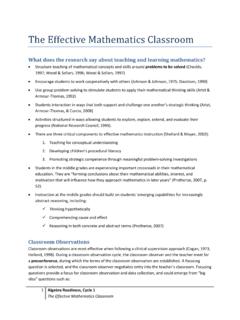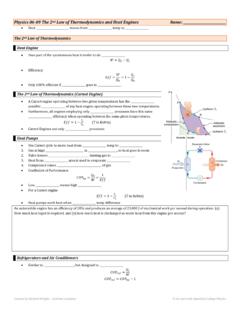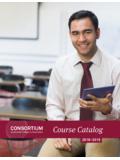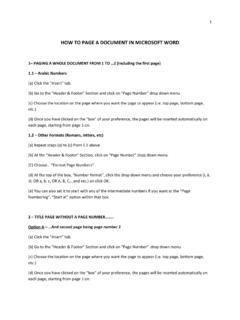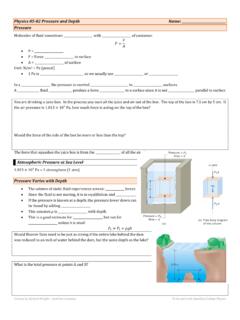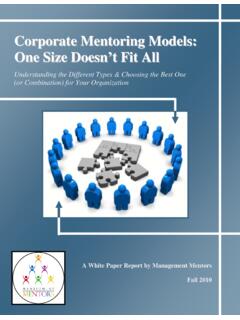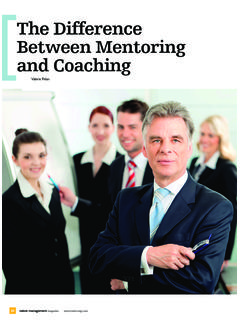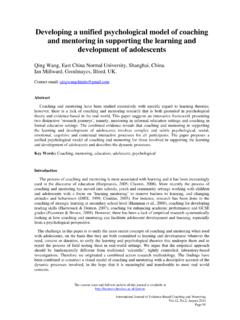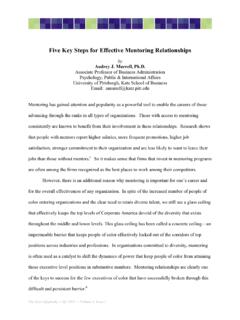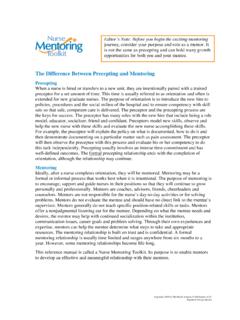Transcription of 1. The of Mentoring and Mentoring - Andrews …
1 Brazil Leadership Program (Session 2) LEAD648: Mentoring (2 cr) Competency Connection: Competency 2A 1. The Changing Paradigms of Mentoring Mentoring has a long history. It is often understood as one competent master sharing resources with a less competent prot g e. This relationship is a learning relationship and therefore affected by the assumptions the mentor and the mentee bring to the learning relationship (see Philosophical Foundations). In this program we use a learner centered approach to learning in harmony with the principles learned in the course on learning strategies. Mentoring consists therefore of creating a learning environment for adult learners. Learning Theory and Mentoring The connection between learning and Mentoring has been explored by Daloz (1999) and Zachary (2000). It is summarized in Exhibit 1.
2 Exhibit 1: Elements in the Learner centered Mentoring Paradigm Mentoring Element Changing Paradigm Adult Learning Principle Mentee role From: Passive ReceiverTo: Active Partner Adults learn best when they are involve in diagnosing, planning implementing , and evaluating their own learning Mentor role From: AuthorityTo: Facilitator The role of the facilitator is to create and maintain a supportive climate that promotes the conditions necessary for learning to take place Learning process From: Mentor directed and responsible for mentee s learning To: Self directed and mentee responsible for own learning Adult learners have a need to be to be self directing. Length of relationship From: Calendar focusTo: Goal determined Readiness of learning increases when there is a specific need to know. Mentoring relationship From: One life=One mentor; one mentor = one mentee To: Multiple mentors over a lifetime and multiple models for Mentoring : individual, group, peer models Life s reservoir of experience is a primary learning resource; the life experiences of other add enrichment to the learning process.
3 Setting From: Face to faceTo: Multiple and varied venues and opportunities Adult learners have an inherent need for immediacy of application. Focus From : Product oriented : knowledge transfer and acquisition To: Process oriented: critical reflection and application Adults respond best to learning when they are internally motivated to learn Source: Lois J. Zachary, The Mentors Guide (San Francisco, CA: Jossey Bass, 2000), pg. 6. The Development of a Mentor Before mentors can effectively help others learn it is important that they become aware of their own learning journey (see Exhibits 3 4). They also must ask themselves why they want to mentor somebody and how comfortable they feel with the key skills necessary for effective Mentoring (see Exhibit 2). One of the key skills in the Mentoring relationship is the ability to reflect on experience (see Exhibit 5).
4 Developing a Mentoring Relationship Mentors approach their work as facilitators of learning. Learning is the fundamental process and the primary purpose of Mentoring (Zachary 2000:1). In this learning journey the relationship between mentor and mentee is a learning partnership during which both grow and develop. It is important that in this partnership both develop meaningful points of connection as a foundation for a productive learning relationship (see Exhibit 6). Exhibit 6: Points of Connection What to Do How to Do It Invest time and effort in setting the climate for learning. Determine the mentee learning styles and needsBe sensitive to the day to day needs of your mentee. Spend time connecting with your mentee. Ask enough questions to give you sufficient insight into your mentee s work context. Identify the multiple venues for all available options: e mail, videoconference, new Web based technologies, telephone, mail and emerging technology and use more than one.
5 Look for opportunities to connect face to face even at a long distance. Set a regular contact schedule, but be on mutually convenient contact schedule, and make sure it works for you and your mentee. If you need to negotiate a schedule appointment, use that situation as an opportunity for connection and interaction. Check on the effectiveness of questions: Are we connecting? Is the means that we are using working for us? Is it convenient? Make sure that connection results in meaningful learning. Is learning going on? Is the mentee making progress? Share information and resources but never as a substitute for persoal interaction. Set the stage to share information. Then share the information and fallow up once the information is shares Source: Zachary, Lois J. (2000). The Mentor s Guide. San Francisco, CA: Jossey Bass.
6 Pg. 37. The Mentoring connection is maintained by effective communication. Zachary indicates that monitoring the Mentoring communication involves the following (pg. 37 38): Actively listen Check out assumptions about what is going on periodically. Share thoughts and feelings candidly. Maintain sensitivity about the mentee s personal and learning needs. Discuss accountability and follow up regularly. Reflect on the learning taking place. Focus on the mentee learning goals. Zachary s Four phase Mentoring model Mentoring relationships move through four phases similar to the seasons of the growth of a plant: 1. Preparing (tilling the soil before planting) 2. Negotiating (planting the seed) 3. Enabling (nurturing growth) 4. Coming to closure (bringing in the harvest) These four phases can be seen as a cycle of seasons.
7 Preparing Mentors preparation starts with self awareness as they reflect on their own personal learning journey. Avoid mentor cloning (projecting your own experience onto the mentee). Understand your role in facilitating effective learning relationships. Explore your motivation for and your readiness to be a mentor. Assess your Mentoring skills to identify areas of needed learning and development. Evaluate the viability of the prospective relationship. Have an initial conversation with the mentee to determine how the Mentoring relationship might be developed. Preparing Negotiating Closing Enabling Negotiating This is the business phase of the relationship: you agree on learning goals, content and processes. You develop the ground rules how you want to move in your journey of learning. You must clarify expectations, assumptions, goals, and needs, and topics like confidentiality, boundaries, and limits.
8 Details like when and how to meet, responsibilities, criteria and milestones for success, accountability, how to bring closure are spelled out in a Mentoring agreement (see Exhibit 7 and 8). Enabling In this complex phase the learning relationship is implemented. In this phase it is crucial to build a level of trust and effective communication that will lead to a qualitative Mentoring relationship. The nurturing of the mentee s growth is encouraged through establishing and maintaining a an open and affirmative learning climate and providing thoughtful and timely, candid and constructive feedback, and monitoring the learning progress and process to ensure that the mentee s learning goals are met (see Exhibits 9, 10, and 11). This phase is also vulnerable to many potential obstacles which need to be addressed.
9 Closing Closure protocol is established when the Mentoring agreement is established. Evaluating, acknowledging and celebrating achievement of learning outcomes. Opportunity to evaluate personal learning and apply the learning to other relationships and situations. Planning the Mentoring Project (see PLA) Each participant is asked to develop a Mentoring project that involves the development of a Mentoring relationship with one or more persons and the implementation of a learning journey that is built on the learning model discussed. It should be based on a set of written goals established in open negotiation between the mentor and the mentee(s). The project should be the same as described in the PLA. Documenting the Mentoring Project (Project Journal) Each mentor is asked to document the Mentoring experience as a running journal that contains the details of all meetings/communications, the reflections of the mentor about the ongoing processes and the progress of the learning journey towards the learning goals.
10 Other documentation may involve the Mentoring agreement, evaluations of the Mentoring sessions by both, the mentor and the mentees, documentation of achievements, and closure documents. Reporting the Mentoring Project The Mentoring project should be reported in a project report that describes the whole experience in some detail. It should specifically address the following points: How the mentor prepared him (her)self for the experience The learning model used. The work plan o Who? o Why? Answering this question reveals the situation that calls for the educational event ( : the workshop). A good way to respond to this question is to complete the sentence AThe mentee needs ..@ o When? Establishes the time frame (available time). This question invites serious consideration of just how much can be taught in the available time.

